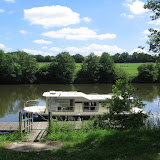Are we there yet? For anyone who is confused, our route was France-Spain-France (see map), but since some of the blog posts were done after our return, they are in the order of my recall, not always chronological. So the last few days of the trip start in Daon, where we return Le Yann. Back in the little Modus and off to Angers to see sights we didn't have time for when we visited by boat: the Cathedral, an Abbey, the modern tapestry museum. Walking through the La Doutre district we fall about when we observe a sign saying "Le Boomerang" Australian Pub, attached to a half-timbered building at least 500 years old (see picture in the Picasa albums): so typical!
From Angers to Chartres, where we spend much of our last day in France in the Cathedral. As it is almost midsummer day we have the special experience of light coming through the north facing windows as well as those facing east, south and west. Between morning and afternoon visits we retire to the hotel to pack ready for an early exit, and so that we can relax and enjoy our last evening. After two strikes (attractive restaurants that prove to be fully booked) we find the perfect place for our last meal and enjoy the "Degustation" menu sitting at a table on the edge of the river, watching passing ducks between the five delicious courses. We walk back to the hotel the long way round to view much of "Chartes en lumieres": moving light shows in streets and on bridges in the old part of the city, as well as on the cathedral and other major buildings.
After almost seven weeks of perfect weather, it pours as we drive back to Paris, making negotiating the Peripherique even more challenging, but we navigate perfectly with the aid of the TomTom satnav. Car return goes smoothly, but the rain has cut power in CDG and we have to wait about an hour before they fire up the emergency power system and we can check in. Business class on Cathay Pacific is somehow not quite as enjoyable as Finnair, even though the seats turn into completely flat beds. It pours in Hong Kong as well, but it doesn't stop us from making a ferry trip out to one of the islands where things are much more third world than in the main part of Hong Kong. Another Cathay Pacific flight brings us home to Melbourne, after a wonderful trip.
Five weeks later we are settling back into winter in Melbourne. I'm fully recovered from a bout of flu and a chest infection, but the broken toe (and possibly another bone in the foot) sustained running down the side deck of the boat to push off in a lock isn't completely mended yet, although I've stopped limping. Catching up with friends and family has been high on the agenda - if we haven't got to you yet to bore you with more trip tales and happy snaps, don't worry, your time will come! If you want to avoid the slide show when we see you, the best of the photos are in our Picasa albums: Part 1: The gite Part 2: Mostly Spain Part 3: Afloat
